Chapter: 11th Botany : Chapter 5 : Taxonomy and Systematic Botany
Types of classification - Taxonomy
Types of classification
Taxonomic entities are classified in three ways.
They are artificial classification, natural classification and phylogenetic
classification.
1. Artificial system of classification
Carolus
Linnaeus (1707 - 1778) was a great Swedish
Botanist and said to be the “Father of
Taxonomy.” He outlined an
artificial system of classification in “Species Plantarum” in 1753,
wherein he listed and described 7,300 species and arranged in 24 classes mostly
on the basis of number, union (adhesion and cohesion), length, and distribution of stamens.
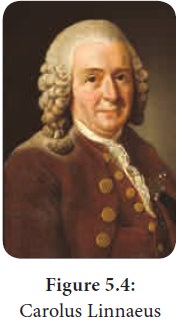
The classes were further subdivided on the basis
of carpel characteristics into orders. Hence the system of classification is
also known as sexual system of
classification.
This system of classification though artificial,
was continued for more than 100 years after the death of Linnaeus, due to its
simplicity and easy way of identification of plants.
However the system could not hold good due to the
following reasons.
1.
Totally unrelated plants were kept in a single
group, whereas closely related plants were placed in widely separated groups.
Example:
a.
Zingiberaceae of monocotyledons and Anacardiaceae
of dicotyledonous were placed under the class Monandria since these possess
single stamens.
b.
Prunus was
classified along with Cactus because
of the same number of stamens.
No attempts were made to classify plants based on
either natural or phylogenetic relationships which exist among plant groups.
2. Natural system
Botanists who came after Linnaeus realised that no
single character is more important than the other characters. Accordingly an
approach to a natural system of classification sprouted in France. The first
scheme of classification based on overall similarities was presented by Antoine Laurent de Jessieu in 1789.
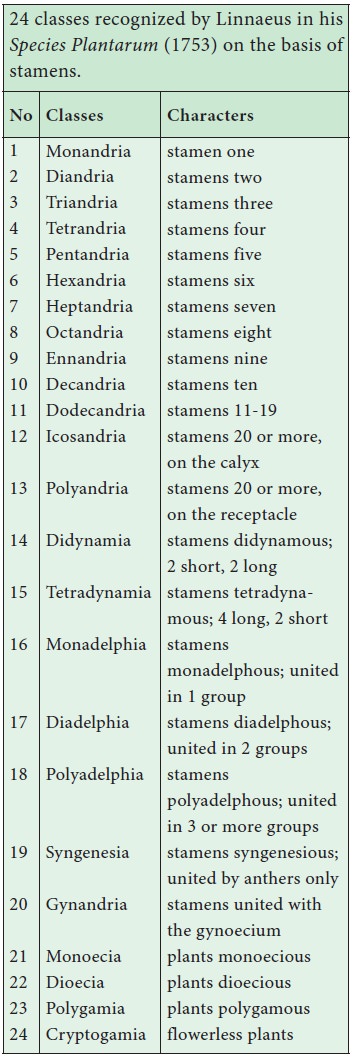
Bentham and Hooker system of classification
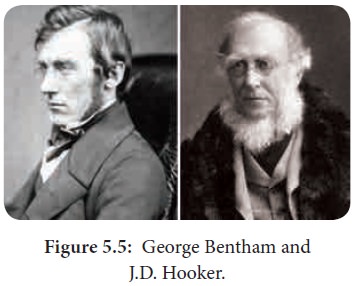
A widely followed natural system of classification
considered the best was proposed by two English botanist George Bentham (1800 - 1884) and Joseph Dalton Hooker (1817–1911). The classification was published in a three volume work as “Genera Plantarum” (1862–1883) describing
202 families and 7569 genera and 97, 205 species. In this system the seeded
plants were classified into 3 major classes such as Dicotyledonae, Gymnospermae
and Monocotyledonae.
Class I
Dicotyledonae: Plants contain
two cotyledons in their seed, leaves with reticulate venation, tap root
system and tetramerous or pentamerous flowers come under this class. It
includes three sub-classes – Polypetalae,
Gamopetalae and Monochlamydeae.
Sub-class
1. Polypetalae:
Plants with free petals and
dichlamydeous flowers come under polypetalae. It is further divided into three
series – Thalamiflorae, Disciflorae and Calyciflorae.

Series
(i) Thalamiflorae: Plants having
flowers with dome or conical shaped thalamus and superior ovary are included in
this series. It includes 6 orders and 34 families.
Series
(ii) Disciflorae: Flowers having
prominent disc shaped thalamus with superior ovary come under this series.
It includes 4 orders and 23 families.
Series
(iii) Calyciflorae: It includes plants having flowers with cup shaped thalamus and with inferior or
sometimes with half inferior ovary. Calyciflorae includes 5 orders and 27
families.
Sub-class
2. Gamopetalae: Plants with united
petals, which are either partially or completely fused to one another and
dichlamydeous are placed under Gamopetalae. It is further divided into three
series – Inferae, Heteromerae and Bicarpellatae.
Series
(i) Inferae: The flowers are
epigynous and with inferior ovary. Inferae includes 3 orders and 9
families.
Series
(ii) Heteromerae: The flowers are
hypogynous, superior ovary and with more than two carpels. Heteromerae includes
3 orders and 12 families.
Series
(iii) Bicarpellatae: The flowers are
hypogynous, superior ovary and with two carpels.Bicarpellatae includes 4 orders
and 24 families.
Sub-class
3. Monochlamydeae: Plants with
incomplete flowers either apetalous or with undifferenciated calyx
and corolla are placed under Monochlamydeae. The sepals and petals are not
distinguished and they are called perianth.
Sometimes both the whorls are absent. Monochlamydeae includes 8 series and 36
families.
Class II
Gymnospermae: Plants that contain
naked seeds come under this class. Gymnospermae includes three families –
Gnetaceae, Coniferae and Cycadaceae.
Class III
Monocotyledonae: Plants contain
only one cotyledon in their seed, leaves with parallel venation, fibrous root
system and trimerous flowers come under this class. The Monocotyledonae has 7
series and 34 families.
The Bentham and Hooker system of classification is
still supposed to be the best system of classification. It has been widely
practiced in colonial countries and herbaria of those countries were organised
based on this system and is still used as a key for the identification of
plants in some herbaria of the world due to the following reasons:
·
Description of plants is quite accurate and
reliable, because it is mainly based on personal studies from actual specimens
and not mere comparisons of known facts.
![]()
![]()
![]()
•
As it is easy to follow, it is used as a key for
the identification of plants in several herbaria of the world.
Though it is a natural system, this system was not
intended to be phylogenetic.
3. Phylogenetic system of classification
The publication of the Origin of Species (1859)
by Charles Darwin has given stimulus
for the emergence of phylogenetic system of classification.
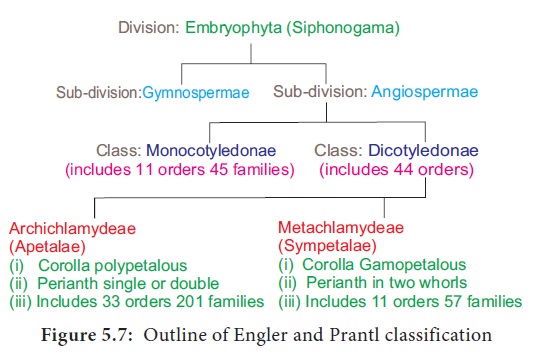
I Adolph Engler and Karl A Prantl system of classification
One of the earliest phylogenetic system of
classification of the entire plant Kingdom was jointly proposed by two German
botanists Adolph Engler ( 1844 -
1930) and Karl A Prantl (1849 -
1893). They published their
classification in a monumental work “Die Naturelichen Pflanzen Familien”
in 23 volumes (1887- 1915)
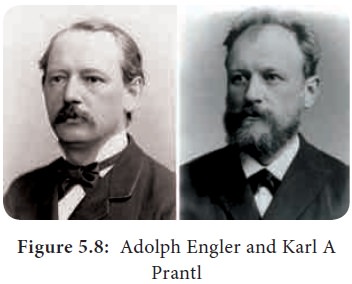
In this system of classification the plant kingdom was divided into 13 divisions. The first 11 divisions are Thallophytes, twelfth division is Embryophyta Asiphonogama (plants with
embryos but no pollen tubes; Bryophytes and Pteridophytes) and the thirteenth
division is Embryophyta Siphonogama (plants with embryos and pollen tubes) which includes seed
plants.
II Arthur Cronquist system of classification
Arthur
Cronquist (1919 - 1992) an eminent American taxonomist proposed phylogenetic
classification of flowering plants based on a wide range of taxonomic

He has presented his classification in
1968 in his book titled “The evolution
and classification of flowering
plants.” His classification is
broadly based on the Principles of phylogeny that finds acceptance with major
contemporary authors.

Cronquist classified the angiosperms into two main classes Magnoliopsida (=dicotyledons) and Liliopsida (= monocotyledons). There are 6 subclasses, 64 orders, 320 families and about 165,000 species in Magnoliopsida, whereas in Liliopsida there are 5 sub classes, 19 orders, 66 families and about 50,000 species.
Cronquist system of classification also could not
persist for a long time because, the system is not very useful for
identification and cannot be adopted in herbaria due to its high phylogenetic
nature.
4. Angiosperm phylogeny group (APG) classification
The most recent classification of flowering plants based on phylogenetic data was set in the last decade of twentieth century. Four versions of Angiosperm Phylogenetic Group classification (APG I, APG II, APG III & APG IV) have been published in 1998, 2003, 2009 and 2016 respectively. Each version supplants the previous version. Recognition of monophyletic group based on the information received from various disciplines such as gross morphology, anatomy, embryology, palynology, karyology, phytochemistry and more strongly on molecular data with respect to DNA sequences of two chloroplast genes (atpB and rbcL) and one nuclear gene (nuclear ribosomal 18s DNA).
The most recent updated version, APG IV (2016)
recognised 64 orders and 416families. Of these, 416 families 259 are
represented in India.
The outline of APG IV classification is given
below.
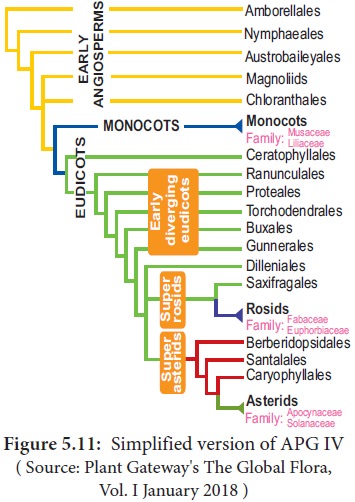
Angiosperms are classified into three clades early
angiosperms, monocots and eudicots. Early angiosperms are classified into 8 orders and 26 families (ANA-grade + magnoliids + Chloranthales)
Amborellales Nymphaeales Austrobaileyales
➢ Seeds
always with two cotyledons.
➢ Presence
of ethereal oils.
➢ Leaves
are always simple net-veined.
➢ Each
floral whorls with many parts.
➢ Perianth
usually spirally arranged or parts in threes.
➢ Stamens
with broad filaments.
➢ Anthers
tetrasporangiate.
➢ Pollen
monosulcate.
➢ Nectaries
are rare.
➢ Carpels
usually free and.
➢ Embryo very small.
Monocots are classified into 11
orders and 77 families (basal monocots + lilioids + commelinids)
➢ Seeds
with single cotyledon.
➢ Primary
root short-lived.
➢ Single
adaxial prophyll.
➢ Ethereal
oils rarely present.
➢ Mostly
herbaceous, absence of vascular cambium.
➢ Vascular
bundles are scattered in the stem.
➢ Leaf
simple with parallel-veined.
➢ Floral
parts usually in threes.
➢ Perianth
often composed of tepals.
➢ Pollen
monosulcate.
➢ Styles
normally hollow and.
➢ Successive
microsporogenesis.
Eudicots are divided into 45 orders and 313
families (early diverging eudicots + super rosids + super asterids).
➢ Seeds
with always two cotyledons.
➢ Nodes
trilacunar with three leaf traces.
➢ Stomata
anomocytic.
➢ Ethereal
oils rarely present.
➢ Woody or
herbaceous plants.
➢ Leaves
simple or compound, usually net-veined.
➢ Flower
parts mostly in twos, fours or fives.
➢ Microsporogenesis
simultaneous.
➢ Style
solid and .
➢ Pollen
tricolpate.
![]()
![]()
![]()
APG system is an evolving system that might undergo
change periodically based on the new sets of data from various disciplines of
Botany. It is the currently accepted system across the world and followed by
all the leading taxonomic institutions and practising taxonomists. However, it
is yet to percolate into the Indian botanical curriculum.
Changes in earlier taxonomic understanding.
The newly proposed APG classification
system has brought many changes in our earlier understanding on the concept of
primitive flowering plant families. Some of them are given below:
•
The real Ranalean families,
especially the arborescent ones are no more the primitive families. But as per
APG classification system, Amborellaceae, Nymphaceae, Austrobaileyaceae,
Magnoliaceae and Chloranthaceae form the early angiosperms.
•
Monocots are recognised as a
monophyletic group and hence terminology is retained.
•
Dicots are polyphyletic group and as
a result the use of the term dicotyledons as a group becomes outdated.
•
Liliaceae (Sensu lato) is split into
14 families.
•
Molluginaceae and Gisekiaceae are
recognised separately from Aizoaceae.
•
Euphorbiaceae (s.l.) is split in to
Phyllanthaceae, Picrodendraceae and Putranjivaceae.
•
Asclepiadaceae are merged with
Apocynaceae (s.l.)
Many genera that were conventionally
treated under Verbenaceae such as Clerodendron,
Tectona and Vitex are transferred to Lamiaceae based on the modified
circumscription of these families.

Classification reflects the state of our knowledge
at a given point of time. It will continue to change as we acquire new
information.
A significant number of major herbaria,
including Kew are changing the order of their collections in accordance with
APG.
The influential world checklist of
selected plant families (also from kew) is being updated to the APG III system.
A recent photographic survey of the
plants of USA and Canada is organized according to the APG III system.
In UK, the latest edition of the
standard flora of the British Isles written by Stace is based on the APG III
system.
Related Topics